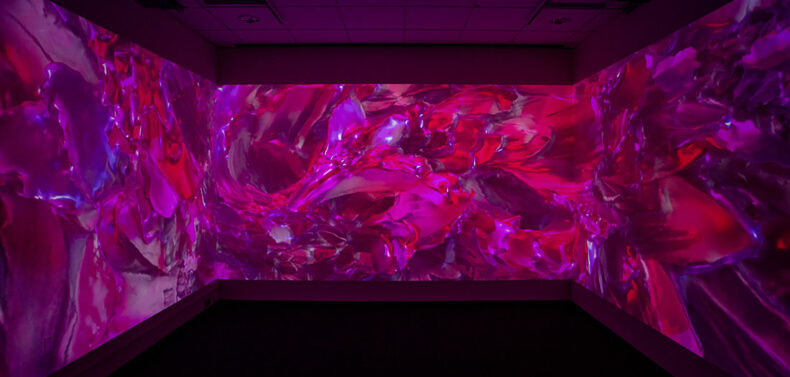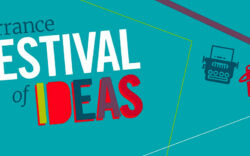As technological advances lead to a rise in the popularity and accessibility of digital art, many creative tools risk erasing an artist’s mark or the human touch that often makes artwork feel so personal and precious. Interdisciplinary new media artist Nancy Baker Cahill redefines the possibilities of drawing in contemporary art by blurring the boundaries between analog and digital production. Currently on view at the Georgia Museum of Art, “Nancy Baker Cahill: Through Lines” is a mid-career survey exhibition that traces the artist’s hybrid practice as it moves between traditional mark-making and technologically-based techniques to bridge the physical and virtual worlds.
Located outdoors in the Jane and Harry Willson Sculpture Garden, “Margin of Error” is an animated, geolocated AR installation that expands the boundaries of land art. Unlike most traditional works that physically alter or manipulate the landscape in some way, Cahill’s is monumental yet leaves no trace. This particular installation “imagines an inevitable, toxic and ungovernable outcome created by humans’ impact on the environment.” Here, an impending climate catastrophe is represented by a swirling vortex of colorful shards and pure obliteration.
As the photograph on this week’s Flagpole illustrates, the installation is revealed when using a smartphone application called 4th Wall, a free AR public art platform founded by Cahill. Challenging traditional conventions of public art, 4th Wall aims to provide participatory, immersive art experiences and increase access to fine art through augmented reality. Like its name suggests, the app “breaks the fourth wall” not only by pulling viewers into the artwork’s narrative, but by establishing an art-viewing alternative to the walls of institutions.

“Through Lines” traces Cahill’s artistic process as it moves through various media, evolving from drawings and three-dimensional sculptural installations into single- and multi-channel videos and digital works of art in AR. Moving counterclockwise through the main gallery, the exhibition begins with “The Conversation,” a large-scale graphite drawing on paper, and “Distortions 05,” a graphite and mixed media work that incorporates digital motifs like pixelated squares.Two-dimensional drawing-based works such as these set the foundation for Cahill’s explorations into the digital realm.
“Slipstream 100” is a three-dimensional wall work created from torn graphite drawings on paper. The thin scraps of paper resemble botanically shaped petals that explode from the corner of the room and sprawl outward. In her “Slipstream” series, Cahill scans, animates and digitally alters paper sculptures to create videos such as “Slipstream Canon” and “Lascaux.” These works push the limits of drawing through new media while preserving the hand-drawn line as an integral component.
The exhibition comes full circle with a pair of vibrant fine art prints, “Slipstream 17” and “Slipstream 18,” that are cinematic stills extracted from animated videos. By focusing on the prints through the 4th Wall app, the images can be reanimated. The exhibition’s flow then brings viewers to the final stop in this room, a large window offering a different bird’s-eye perspective on “Margin of Error.”
On view in the Alonzo and Vallye Dudley Gallery, which focuses on new media art, “Petit Mort” is an immersive video installation that swallows viewers into a pulsating, shimmering landscape of hot pinks and purples flowing across three walls. Part of her “Slipstream: Table of Contents” series, the video references slipstream, a genre of speculative fiction that makes “the familiar strange or the strange familiar” by questioning reality.
Curated by Kathryn Hill, curatorial assistant in contemporary art, “Through Lines” is Cahill’s first solo museum show. Cahill also has an AR artwork currently on view at the Whitney Museum of American Art that can be viewed from any location using 4th Wall. Entitled “CENTO,” the installation is “a bioengineered, future AR creature whose evolutionary survival depends on collective engagement” through equipping the bird-like organism with feathers representing energy conversion, toxic filtration, communication and other tools for navigating an imperiled ecosystem.
“Through Lines” will remain on view at the Georgia Museum of Art until May 19, and is scheduled to travel to Villanova University Art Gallery in Pennsylvania in the fall. The museum will be closed Dec. 24–26 and Dec. 31–Jan. 2 for the holidays, but is otherwise open Tuesdays through Sundays.
Like what you just read? Support Flagpole by making a donation today. Every dollar you give helps fund our ongoing mission to provide Athens with quality, independent journalism.










